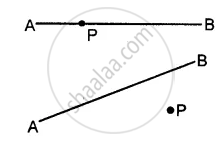AO = BO
= 2.9 cm
Draw a line segment of given length and construct a perpendicular bisector to line segment using scale and compass
58 mm
58 mm = `58 xx 1/10` cm = 5.8 cm

Construction:
Step 1: Drawn a line. Marked two points A and B on it so that
AB = 5.8 cm = 58 mm.
Step 2: Using compass with A as centre and radius more than half of the length of AB, drawn two arcs of the same length one above AB and one below AB.
Step 3: With the same radius and B as centre drawn two arcs to cut the arcs of drawn in step 2.
Marked the points of intersection of the arcs as C and D.
Step 4: Joined C and D. CD intersects AB. Marked the point of intersection as O.
CD is the required perpendicular bisector.
∠AOC = 90°
AO = BO
= 2.9 cm
Draw a line segment PQ = 4.8 cm. Construct the perpendicular bisector of PQ.
In each of the following, draw perpendicular through point P to the line segment AB :
(i)

(ii)

(iii)

Draw a line segment AB = 5.5 cm. Mark a point P, such that PA = 6 cm and PB = 4.8 cm. From point P, draw a perpendicular to AB.
Draw a line segment of given length and construct a perpendicular bisector to line segment using scale and compass
7 cm
Infinitely many perpendiculars can be drawn to a given ray.
Draw a line segment of length 7 cm. Draw its perpendicular bisector, using ruler and compasses.
Copy figure on your notebook and draw a perpendicular from P to line m using (i) set squares (ii) protractor (iii) ruler and compass. How many such perpendicular are you able to draw?
Draw an angle of 60° using ruler and compasses and divide it into four equal parts. Measure each part.
Bisect a right angle, using ruler and compasses. Measure each part. Bisect each of these parts. What will be the measure of each of these parts?
Draw a line segment of length 10 cm. Divide it into four equal parts. Measure each of these parts.